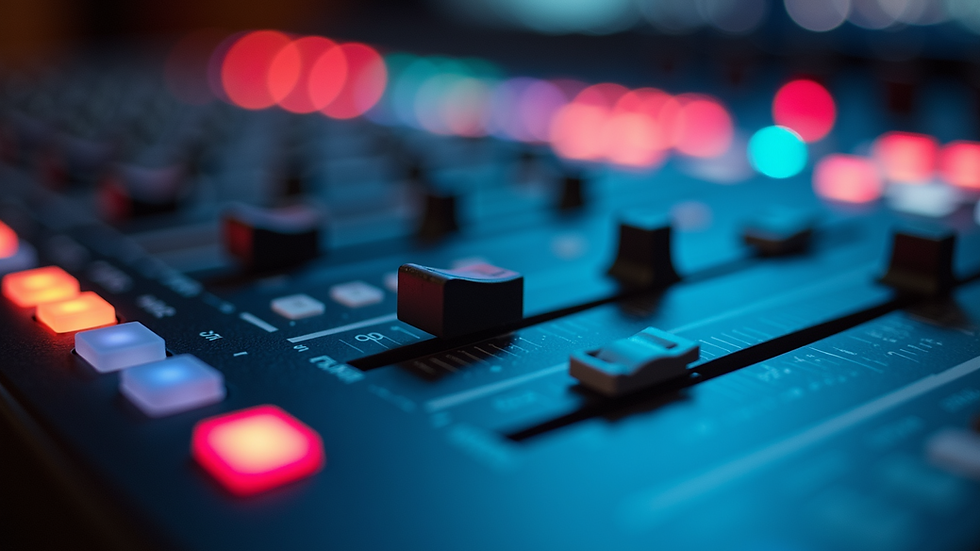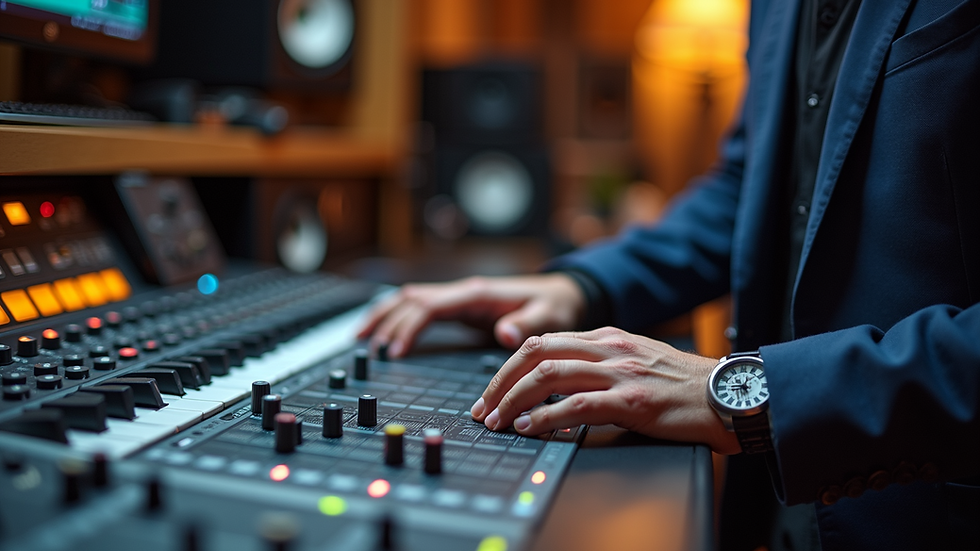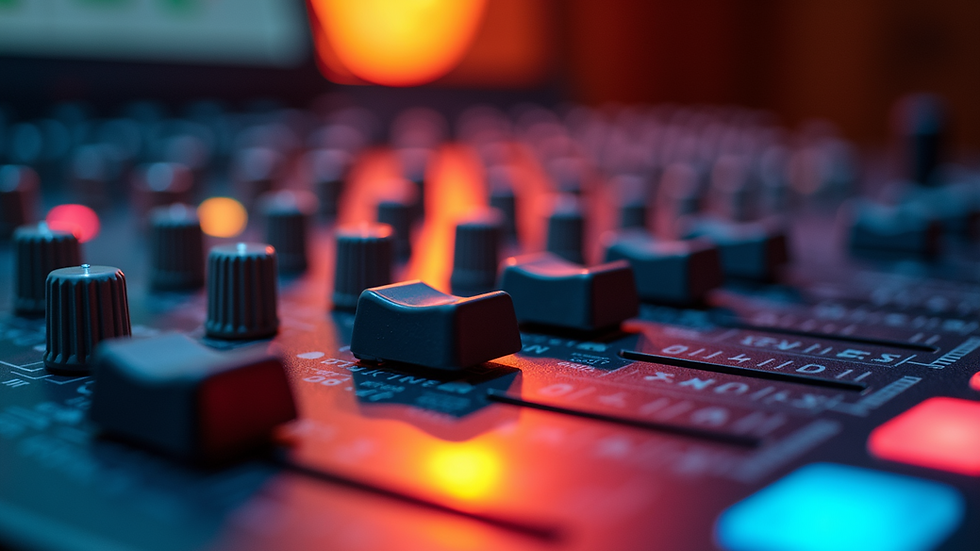Master Your Music: Expert Mixing Tips and Tricks
- jvonjackson13
- Jul 24
- 5 min read
Mixing music is an art form that can elevate your tracks from good to great. Whether you are a budding producer or a seasoned musician, mastering the mixing process is essential. In this post, we will explore expert tips and tricks that can help you refine your mixing skills.
Mixing is not just about balancing levels; it is about creating a cohesive sound that resonates with listeners. With the right techniques, you can make your music shine. Let’s dive into some practical advice that can transform your mixing game.
Understanding the Basics of Mixing
Before you start mixing, it is crucial to understand the basics. Mixing involves combining multiple audio tracks into a single stereo track. This process includes adjusting levels, panning, equalization, and adding effects.
Here are some fundamental concepts to keep in mind:
Levels: Ensure that each track is at an appropriate volume. Avoid clipping, which can distort your sound.
Panning: Distribute sounds across the stereo field. This creates space and dimension in your mix.
Equalization (EQ): Use EQ to enhance or reduce certain frequencies. This helps each instrument sit well in the mix.
Effects: Reverb, delay, and compression can add depth and character to your tracks.
Understanding these basics will set a solid foundation for your mixing journey.
Setting Up Your Mixing Environment
Your mixing environment plays a significant role in how your music sounds. Here are some tips to create an optimal space for mixing:
Choose the Right Room: A room with minimal reflections and good acoustics is ideal. Avoid mixing in small, cluttered spaces.
Monitor Placement: Position your studio monitors at ear level and form an equilateral triangle with your listening position. This ensures accurate sound reproduction.
Use Acoustic Treatment: Consider adding bass traps, diffusers, and absorbers to control sound reflections. This will help you hear your mix more clearly.
Creating a suitable mixing environment can significantly improve your results.
The Importance of Reference Tracks
Using reference tracks is a powerful technique that can guide your mixing decisions. A reference track is a professionally mixed song that you admire. Here’s how to use them effectively:
Select Tracks in the Same Genre: Choose songs that are similar in style to your own. This will give you a better context for your mix.
Analyze the Mix: Listen closely to the levels, EQ, and effects used in the reference track. Take notes on what you like and what you want to achieve.
Compare While Mixing: Regularly switch between your mix and the reference track. This will help you stay on track and make necessary adjustments.
Reference tracks can serve as a valuable benchmark for your mixing process.
Balancing Levels Like a Pro
Achieving a balanced mix is crucial for clarity and impact. Here are some tips for balancing levels effectively:
Start with the Drums: Begin by mixing your drum tracks. They often serve as the backbone of your mix.
Use the Fader: Adjust the fader levels for each track. Make sure no single element overwhelms the others.
Check in Mono: Occasionally switch to mono to ensure your mix sounds good on all systems. This helps identify any imbalances.
Balancing levels is an ongoing process that requires careful listening and adjustments.
Mastering EQ Techniques
Equalization is one of the most powerful tools in mixing. Here are some EQ techniques to enhance your tracks:
Cut Before You Boost: If a frequency is too prominent, try cutting it instead of boosting others. This often leads to a cleaner mix.
Use High-Pass Filters: Apply high-pass filters to remove unnecessary low frequencies from non-bass instruments. This clears up space in the mix.
Identify Problem Frequencies: Use a narrow Q setting to find and reduce problematic frequencies. This can help eliminate muddiness.
Mastering EQ techniques can greatly improve the clarity of your mix.
Panning for Depth and Space
Panning is essential for creating a sense of space in your mix. Here are some tips for effective panning:
Create Width: Pan instruments across the stereo field to create a wider sound. For example, you might pan guitars slightly left and right.
Keep the Low End Centered: Bass and kick drums should generally remain centered in the mix. This provides a solid foundation.
Use Automation: Consider automating panning for certain sections of your song. This can add interest and movement.
Panning can transform a flat mix into a dynamic listening experience.
Adding Effects Wisely
Effects can enhance your mix, but they should be used judiciously. Here are some tips for adding effects:
Use Reverb Sparingly: While reverb can add depth, too much can muddy your mix. Use it to create space without overwhelming the sound.
Experiment with Delay: Delay can add dimension and interest. Try using it on vocals or lead instruments for a fuller sound.
Compression for Control: Use compression to control dynamics and add punch. Be careful not to over-compress, as this can squash the life out of your mix.
Adding effects wisely can elevate your mix without detracting from the core elements.
The Art of Automation
Automation is a powerful tool that allows you to control various parameters over time. Here’s how to use automation effectively:
Volume Automation: Use volume automation to create dynamic changes throughout your track. This can help maintain listener interest.
Effect Automation: Automate effects like reverb or delay to enhance specific sections. This adds excitement and variation.
Panning Automation: Consider automating panning for certain instruments to create movement and depth.
Automation can bring your mix to life and keep it engaging.
Finalizing Your Mix
Once you have completed your mix, it is time to finalize it. Here are some steps to ensure your mix is polished:
Take Breaks: Step away from your mix for a while. Fresh ears can help you identify issues you may have missed.
Check on Different Systems: Listen to your mix on various speakers and headphones. This will help you ensure it translates well across different playback systems.
Get Feedback: Share your mix with trusted friends or fellow musicians. Constructive feedback can provide valuable insights.
Finalizing your mix is an important step that can make a significant difference in the final product.
Keeping the Creative Flow
Mixing can sometimes feel overwhelming, but it is essential to keep the creative flow going. Here are some tips to maintain your creativity:
Set Time Limits: Give yourself a specific amount of time to work on your mix. This can help you stay focused and avoid overthinking.
Experiment: Don’t be afraid to try new techniques or effects. Mixing is a creative process, and experimentation can lead to exciting results.
Stay Inspired: Listen to new music and explore different genres. This can spark new ideas and keep your mixing fresh.
Keeping the creative flow alive is crucial for producing great music.
Wrapping It Up
Mixing is a skill that takes time and practice to master. By applying these expert tips and tricks, you can enhance your mixing abilities and create music that truly stands out. Remember to focus on the basics, trust your ears, and keep experimenting.
With dedication and creativity, you can take your music to new heights. Happy mixing!



Comments